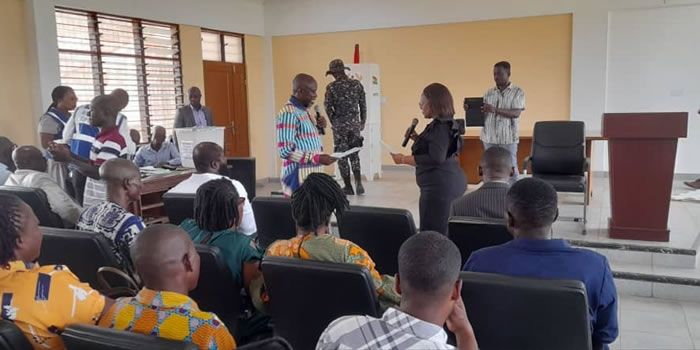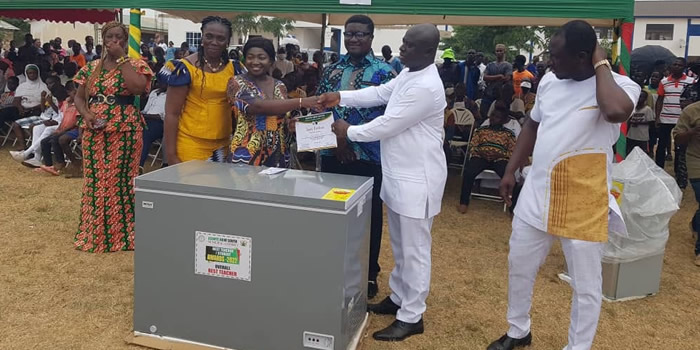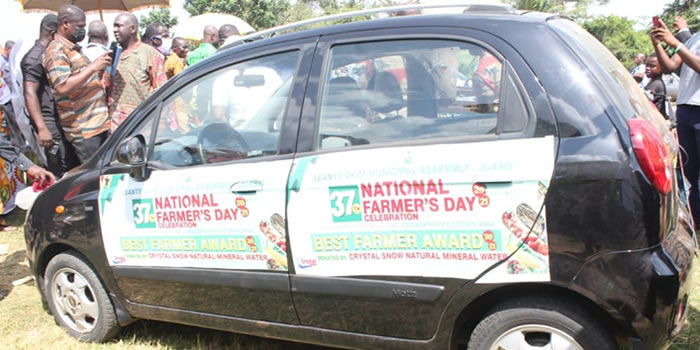

Roads and Railways
Apart from the Accra – Kumasi trunk road that runs through the district from Nndadieso to Yawkwei (26km of asphalted road), the Asankare – Bompata (6km) tarred road and the recently tarred Juaso – Obogu road plus the on-going Obogu-Ofoase road surfacing works, all others in the district are laterite feeder roads. However, such roads as Obogu-Nkyesa, Juaso-Bompata-Kurofa, Asankare-Dampong and Ofoase-Banka are fairly good throughout the
The conditions of roads in the district are generally poor and several farming communities are inaccessible, particularly during the rainy season. Some of the worst feeder roads include the Banka – Tokwai road. This makes transportation of people and goods very difficult and expensive. In most of the smaller communities, the most reliable means of transport is by foot since very few vehicles ply the routes. One of the major causes of the poor conditions of road network is the lack of periodic maintenance of the roads.
The Accra – Kumasi railway line passes through the district and has the potential of boosting commercial activities. However, the rails have broken down and have not been in operation for the past four years. This has slowed down businesses and increased unemployment. The repair of the rail line is panacea for development of the towns near the rail lines.
The lack of adequate means of transport to connect communities to marketing centres encourages subsistence production. The situation also adversely affects the health and educational sectors, especially in the execution of routine outreach programmes of agencies in charge of these sectors. The poor network and conditions of feeder roads have contributed immensely to the underdevelopment of the district, especially the north-eastern part. Education and Health Institutions remain in accessible to most residents of the district on account of the poor roads.
Telecommunication and Postal Services
Telecommunication facilities though not adequate are available at Juaso, Obogu, Kurofa, Atwedie, Asankare, Dampong and Morso, courtesy private communication centre operators. GSM Telecom Mobile facilities for TIGO, AREEBA and ONE TOUCH are also accessible at Juaso and some locations in the district. Postal Services are available at Juaso, Atwedie, Asankare, Obogu and Bompata. EMS (Expedited Mail Service) is provided at Juaso.
Energy
Firewood is the main source of domestic energy (84%) and kerosene, a major spruce of lighting in homes. Only Fifteen communities in the district (mainly the big settlements like Juaso, Obogu, Asankare, Bompata, Asuboa, Dampong, Atwedie, Kurofa, Adomfe, Wankyi, Praso, Nnadieso, Nkwanta, Pra-River and Morso) are currently connected to the national electricity grid. Work is currently going on to connect Amantia and Morunaim, Ahyiresu and Muramura to the national grid under the Fourth Self Help Electrification Programme (SHEP 4). Ofoase, Banso Dwendwenase, and other settlements are expected to be included under the programme in 2006. To promote industrial development and thus improve living standards, there is the need to speed up the Rural Electrification project in the district
Other types of energy, which are used throughout the district, include kerosene and fuel wood. They are used mainly for domestic and, to a lesser extent, industrial purposes.
Fire Services Station
The district has no fire station yet. It is serviced by the Konongo station – a distance of 9km. There is however a number of community-based fire volunteers that control bushfires.
Water Supply
Juaso and Obogu have very reliable pipe-borne water supply under the Small Towns Water System. Atwidie and Bompata will soon have pipe borne water under the same system. A good number of the communities have boreholes and hand-dug wells as their sources of water for domestic use. More and more communities continue to benefit from borehole facilities under various water and sanitation programmes.
Market
There are six main periodic markets in the district. They are Obogu market, which is held on Tuesdays, Adomfe, Ofoase and Kyempo markets on Fridays, Dampong market on Wednesdays and Juaso markets on Sundays. Obogu market is the biggest market in the district There are 22 markets constructed throughout the District. Out of these 8 are currently non-functional due to the refusal of traders to move there. Eight of the markets are weekly markets. The relatively bigger and active markets are Obogu, Ofoase, Adomfe and Juaso
The service sector
The service sector, which is dominated by commercial activities, constitutes the second largest sector of the local economy after agriculture. It employs about 18 per cent of the employed labour force.
Markets and other Commercial Activities
There are four main periodic markets in the district. They are Obogu market, which is held on Tuesdays, Adomfe, Ofoase and Kyempo markets on Fridays, Dampong market on Wednesdays and Juaso markets on Sundays. Obogu market is the biggest market in the district. A number of traders also sell farm produce along the main Kumasi-Accra road. The major problems that traders and farmers face in accessing these markets are high transport charges. This is due to the poor conditions of feeder roads in the district.
Table 5.2: Periodic Markets Days and Location
MARKET LOCATION | MARKET DAYS |
Obogu | Tuesday and Fridays |
Adomfe | Fridays |
Kyemp0o | Fridays |
Ofoase | Fridays |
Dampong | Wednesdays |
Juaso | Sundays |
Source: DADU, Juaso 2014.
Twenty-five per cent of commodities traded in the district are cloths, 5 per cent hardware, 45 per cent foodstuffs, 15 percent “provisions” and 10 percent are second hand clothing. The farm produce is mainly plantain, cassava, cocoyam, kola palm oil, gari, rice and maize.
Most of the manufactured commodities are brought from places like Kumasi, Konongo and Nkawkaw, which are all outside the district .Most of the traders in the district are retailers and majority of them sell their goods within the district.
The major problems that the traders face in the district are high transport charges, lack of credit facilities and fluctuation commodity of prices, which make their incomes unstable.
Information, Communication Technology (ICT)
ICT centres are almost non-existence in the District, there is no internet café/centre in the district due to poor telephone reception. There are no fixed telephone lines in the district. However, The Assembly has earmarked three communities for the construction of Community ICT centres. Apart from two SHS, no school has introduced ICT to its curricula. With the introduction of ICT in the curricula of basic schools as an examinable course, there is the need for the District Assembly to ICT centres to enhance teaching and learning of the subject.
Date Created : 11/28/2017 2:33:00 AM












 facebook
facebook
 twitter
twitter
 Youtube
Youtube
 +233 593 831 280
+233 593 831 280 0800 430 430
0800 430 430 GPS: GE-231-4383
GPS: GE-231-4383 info@ghanadistricts.com
info@ghanadistricts.com Box GP1044, Accra, Ghana
Box GP1044, Accra, Ghana